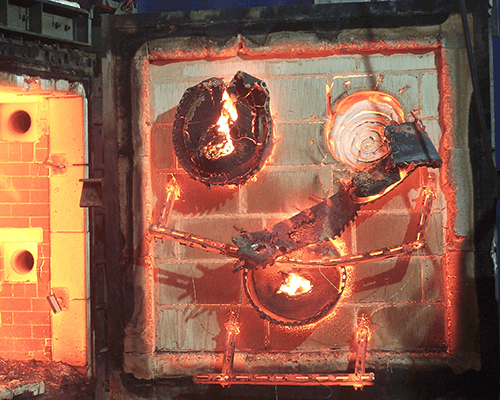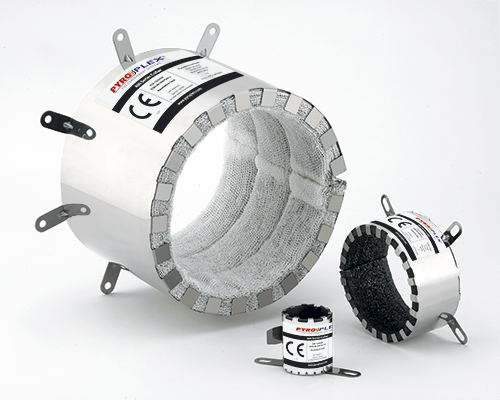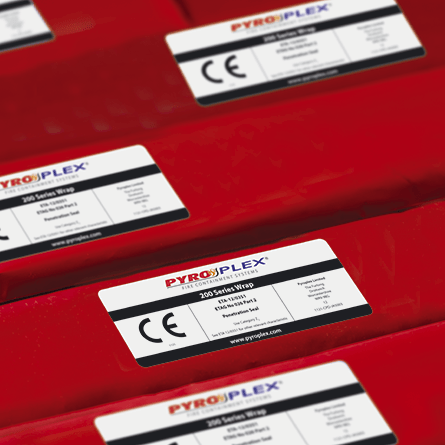 On the 1st of July 2013 the Construction Product Directive (CPD) will be replaced by the Construction Product Regulation (CPR).
On the 1st of July 2013 the Construction Product Directive (CPD) will be replaced by the Construction Product Regulation (CPR).
Whereas the CPD lacked clarity as to when products had to be CE marked, the CPR identifies all products that can be CE marked when they can demonstrate compliance with a CEN (EN) product standard or an EAD (previously ETA), then they can carry the CE mark at the point of sale or installation. Implementation by 1st July will be a tight schedule that may have some manufacturers struggling, not just in the UK, but across Europe. The history of CE marking on fire sealing products portrays some of the complications encountered.
Back in 1985, the European Commission published a White Paper which set the target of abolishing all barriers to trade across the Member States of Europe. These barriers included technical, physical and tax related barriers that could prevent companies in one Member State from selling their goods in another Member State. These barriers were meant to be removed in the following seven years and 1992 became the major target, with numerous Government publications being circulated putting form to the objectives and stressing the need to have certain tasks completed by that year. The Commission believed that a single common market; a market that was satisfied by products which displayed similar properties and performance characteristics was a necessity if any Member States’ companies were to produce products which were competitively priced as a result of the economies of scale which will accrue if the market size is large enough. The Commission visualised that if European companies were to gain an equal share of the global market for products, production levels would need to match those of other major areas of the world e.g. USA, China.
 It was stressed that whilst it was deemed important that the product properties were similar to permit comparison throughout Europe, there was absolutely no intent to harmonise regulations. The harmonisation was restricted to the properties governing fire behaviour so that when fire resistance, or ignitability etc., were called up in Member States’ regulations, the criteria to be satisfied are the same across Europe, regardless of whether the product was produced and tested in Germany, UK, Greece or wherever. Each European country could call up different durations of fire resistance or levels of flame spread as befits the risk associated with their building stock, but the criteria shall be measured in a similar way. The first stage in this harmonisation process was to generate a whole raft of harmonised fire tests that the Member States could adopt in their regulations and for which they could find equivalence in their national requirements.
It was stressed that whilst it was deemed important that the product properties were similar to permit comparison throughout Europe, there was absolutely no intent to harmonise regulations. The harmonisation was restricted to the properties governing fire behaviour so that when fire resistance, or ignitability etc., were called up in Member States’ regulations, the criteria to be satisfied are the same across Europe, regardless of whether the product was produced and tested in Germany, UK, Greece or wherever. Each European country could call up different durations of fire resistance or levels of flame spread as befits the risk associated with their building stock, but the criteria shall be measured in a similar way. The first stage in this harmonisation process was to generate a whole raft of harmonised fire tests that the Member States could adopt in their regulations and for which they could find equivalence in their national requirements.
During the same period, the Commission defined what the essential requirements were for a building; the second of which is ‘Safety in case of fire’. It was stressed that any construction product does not exhibit dangerous behaviour when exposed to fire and must also make a positive contribution to fire safety when designed to do so.
Having defined the performance requirements using the criteria given in the harmonised fire tests (as produced by the European Technical Committee – TC127), the Commission then identified that the Community did not only require harmonised performances against harmonised test methods, it needed harmonised product standards which could identify which of the essential requirements were considered necessary to be satisfied by the products for which appropriate test procedures had been produced.
All of the above activities took place under the mandate of the Construction Product Directive (CPD), but there was confusion within the Commission/Member States as to whether all construction products had to satisfy the CPD and whether they all needed to be marked with the, now increasingly seen, CE mark. This mark is now meant to identify that the product satisfies all of the relevant essential requirements that had been identified in the product standard as being critical. We most commonly see the mark on electrical goods to identify its compliance with the Electrical Equipment (Safety) Regulations 1994, but with construction products it is far more complex and if a product is to be CE marked, it has to demonstrate that it satisfies a much wide range of essential requirements, as follows:

- Mechanical resistance and stability
- Safety in case of fire
- Hygiene health and the environment (release of fibres, etc.)
- Safety in use
- Protection against noise
- Energy economy and heat retention
Whilst some of these are not relevant and can be labelled as ‘no performance’ determined, there are obviously more facets to consider than with electrical goods.
However, the CPD has lacked clarity as to when the products had to be CE marked and few, if any; manufacturers were preparing to mark their products. On the 9th of March 2011 it was announced that the CPD was to be replaced by the Construction Product Regulation (CPR) which would definitely identify that all products can be CE marked if they can demonstrate compliance with a CEN (EN) product standard or an EAD (previously ETA) then they can carry the CE mark at the point of sale or installation. This will be implemented by 1st July 2013, giving manufacturers a challenging, if not, real struggle to comply by this date.
There is a notable exception to this situation Pyroplex Ltd. A member of a UK based Reddiplex Group, Pyroplex have applied significant resources to have its Fire Collars and Pipe Wraps CE marked well in advance of the recommended date. This is notable for a number of reasons. One of the primary objectives was that the companies who manufactured products for use through Europe would grow to a size able to take on the global market. But there was a tendency to believe that only large conglomerates would be able to resource achieving this status. Pyroplex certainly ‘bucks that trend’ whilst being a substantial company, it would not normally attract the title of ‘a conglomerate’. Therefore, as a UK medium-sized enterprise, Pyroplex has achieved the ultimate objective of meeting the requirements that should drive its products further into the world market.
The specialist area in which Pyroplex operates; the manufacture and supply of fire sealing products, is one of those markets where there were also inordinate delays in the preparation of the necessary testing procedures and/or Technical Approval documents- Pyroplex overcame these delays by taking an active role in the drafting process for such documents. This meant that Pyroplex sat alongside the stakeholders from the construction industry, i.e. standards writers, regulators, notified bodies and certification agencies in the UK and Europe, and drew up the missing documents which were then sent out for review, public comment and final editing. This process is robust and ensures that the published standards and approval documents incorporate the correct procedures to demonstrate compliance with the relevant ‘essential’ requirements. Participating in this process gave Pyroplex a head start in getting its products onto the market carrying the CE marking that the Construction Product Regulation will make mandatory.
The Pyroplex range of penetration seals comprises of Pyroplex pipe collars, covering 25mm to 400mm diameter pipes and Pyroplex Pipe Wraps from 55mm to 160mm diameter pipes. Within these ranges, there are individual products with 2hour and 4hour fire resistance periods.
Andy Walsh
Technical Manager
Pyroplex Limited
The Furlong,
Berry Hill Industrial Estate,
Droitwich,
WR9 9BG
